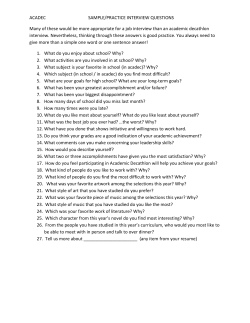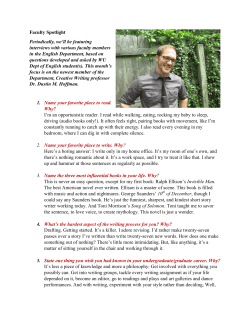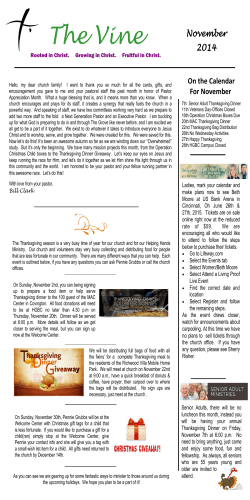
Ways Parents Can Support Reading and Writing at Home
Ways Parents Can Support Reading and Writing at Home Teachers College Reading and Writing Project 1. Let your children see you read for pleasure. Share vocabulary, quotes, characters, and the story with them. Compare similarities and differences between your book and the books your children are reading. 2. Talk to your children about how your parents read to you or told you stories. 3. Let your children see you write for pleasure. Send family letters to relatives or friends. Let everyone in the family contribute a part or an illustration. 4. When you’re riding in the car, tell your children a story about when you were little or tell them a story about something that happened at work that day. Leave off the ending and let them provide an ending. 5. Have your children select three things they want to include in a story. Make up a story that includes those three things. For example, the selections might be a princess, a race car, and an ice cream cone. The children will love helping you find clever ways to include three things in the story. 6. When you look up at the sun/moon or pass a landmark/building, take turns making up a story to go with them. At night, point out the face in the moon and make up a story about the “man in the moon”. Follow up these storytelling events with a trip to the library to explore legends about people and places from our own country and others countries. 7. Try different ambiances for reading a story aloud or storytelling. If it’s a scary story, tell it in the dark or read it with flashlights. If it’s a story about when your child was little, bring out an old toy and hold it as you tell the story. Try themes in your family literacy events. This works naturally with holidays. Find books about the First Thanksgiving and read them aloud. Find pictures of the Thanksgiving holiday and make a collage. Explore foods that go with the Thanksgiving holiday. Make some of these foods and let everyone help read the recipe and prepare the foods. Trade stories about Thanksgiving. 8. Make a family book that is a collection of stories: favorite stories retold generation after generation or stories of family events (first visit by the tooth fairy). Any time that stories are recorded, younger children can dictate to an older family member. 9. Help your child find a place in your home that is his/her favorite reading spot. A place where he/she can read comfortably with little distraction. Put a basket of books near the spot. Include pens, crayons, pencils, erasers and paper in the basket to encourage writing too. Every now and then, put a “literacy gift” in their basket to discover and explore. 10. Read aloud daily to your child. Talk about the pictures. Make predictions about a story and see if they come true. Read aloud a chapter-book before bed. 11. Help your child notice people reading and the writing all around them. Watch other people read. Count all the people on a bus, in a library or café reading. Read signs posted all around you. 12. Visit bookstores and libraries with your child. Window shop as you pass a bookstore, look at the books and imagine the storylines inside them. Then go in and see if your predictions came true. 13. Take books on trips with you. Read to your child on vacation or during a long wait at the doctor’s office. Encourage the people you are visiting to read to your child aloud. 14. Leave notes for your child in his lunch box or school bag. Leave notes for him/her around the house. Ask your child to leave notes for you. Have your child create a to-do list. Have him/her turn it into a checklist to encourage self-monitoring. 15. Encourage friends and relatives to give books to your child as gifts. Markers, colored pencils, pads of paper make excellent birthday or holiday gifts. 16. Subscribe to a children’s magazine and have the magazine sent directly to your child. Show interest when it arrives. “Show me your favorite article.” “I love that picture of ______.” Popular magazines include: Highlights, Click, Ranger Rick, Sports Illustrated for Students, and National Geographic Junior. Large bookstores have many magazines to choose from. Find your favorite magazine and take one of the subscription cards located inside it. 17. Play word games such as Scrabble Junior, Boggle, ABC Bingo, Word Concentration, etc. Tell jokes, riddles and limericks. See how many words rhyme with _________. 18. Encourage your child to read aloud to younger siblings, cousins, neighbors, even stuffed animals. 19. Talk about your own childhood memories. Share your own favorite children’s books and authors. Share your successes and struggles in school. 20. Encourage your child to imagine or share stories from pictures in magazines, newspapers or family photographs. 21. Listen to your child’s retellings and expand them. Encourage them to add more detail. Say, “That would make an amazing story.” Then, imagine the story together.” Say, “You should write about that.” Say, “The way you said that sounds like a poem.” Then, encourage him/her to write it down as a poem. 22. Tell lots of family stories. Ask lots of questions when your child tells you a story. Ask them to identify the beginning, middle, and end or climax of the story. 23. Look back over your child’s writings with them. Notice and praise the growth your child is making as a writer. 24. Encourage your child to bring their writer’s notebook whenever they go on family outings. Whether it’s to grandma’s house, a soccer game or restaurant, there will be plenty to notice, wonder and write about.
© Copyright 2025





















